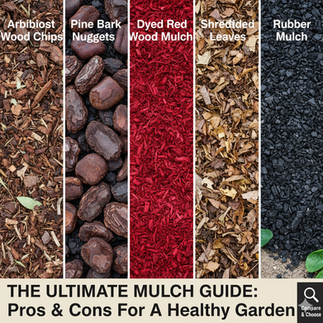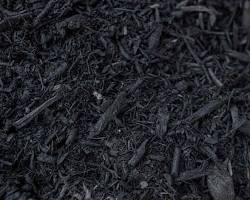The Ultimate Guide to Choosing the Right Mulch For Your Home
- paulceki1205
- 1 day ago
- 5 min read
You're standing in the garden center, staring at a wall of mulch. Black, red, brown, shredded, chunky, pine needles... they all start to blur together. You just want your landscape to look perfect, but you’re frozen. Which one is the right choice?
Here’s the thing: picking the wrong one can be a disaster. You could be inviting pests into your garden, accidentally stealing nutrients from your plants, or even cooking their roots on a hot summer day. You could waste hundreds of dollars and countless hours trying to fix a problem that started with one simple, wrong choice.
It doesn't have to be that complicated. In this guide, we're going to cut through all of that confusion. We'll break down the most popular types of mulch, revealing the hidden pros and cons of each. We’ll bust some common myths, and by the end, you’ll be able to choose the perfect mulch for your home with total confidence.
The Two Main Camps: Organic vs. Inorganic Mulch
Let's simplify this. Every mulch you see falls into one of two main categories.
Organic Mulches are materials that were once alive. Think wood, bark, leaves, and straw. Their biggest advantage is that they decompose. As they break down, they feed your soil, improve its structure, and create a thriving ecosystem for your plants. They are the soil-builders. The downside? Because they break down, you have to reapply them every year or every few years.
Inorganic Mulches are materials that were never alive. This includes things like gravel, stone, landscape fabric, and rubber mulch. Their main selling point is longevity; you apply them once, and they last far longer. But—and this is a huge but—they do absolutely nothing to improve your soil. In some cases, they can actually harm it.
For a truly healthy and sustainable garden, organic is almost always the way to go. So let's start there.
The Classics: Wood and Bark Mulches
When you think of mulch, you probably picture shredded wood or bark. These are by far the most popular choices.
Shredded Hardwood Mulch: This is finely shredded, and it knits together to form a mat that’s great for staying in place on slopes. It does a fantastic job of suppressing weeds and holding moisture. The one downside is that if you lay it on too thick, it can compact and block water from getting to the soil.
Bark Mulches (Pine or Cedar): These are chunkier than shredded hardwood. That airy texture is great for allowing water to flow through easily, and they break down more slowly. Cedar mulch has the added benefit of containing natural oils that can help repel certain insects.
The main purpose of any of these wood mulches is to build the soil over time. They decompose, add organic matter, and feed the beneficial fungi and bacteria that your plants depend on.
Myth: "Won't wood mulch 'rob' nitrogen from the soil?"
This is a common concern, but it's mostly a myth. It's true that wood needs nitrogen to decompose, but this only happens right at the surface where the mulch and soil meet. As long as you're not tilling the mulch into your soil, and you're only applying a 2 to 3-inch layer on top, it won’t affect your plant's roots. The long-term benefits of the nutrients it adds back far outweigh this minor, temporary nitrogen draw.
The Lightweight Champion: Pine Straw
Now let's talk about pine straw (pine needles). If you have plants that love acidic soil, like azaleas, rhododendrons, or blueberries, pine straw is a fantastic option. It’s very lightweight, easy to spread, and the needles interlock, which means it stays put and won't wash away in heavy rain—making it perfect for slopes.
Myth: "Will pine straw make all my soil too acidic?"
This is the biggest myth about pine straw. While fresh pine needles themselves are acidic, they are neutralized by microbial activity as they decompose on top of the soil. The bare ground you often see under pine trees is usually due to the dense shade and competition for water, not because the soil is overly acidic. You can confidently use pine straw anywhere in your garden.
The Best-Kept Secret: "Free" Mulches
Before we get to the controversial stuff, I want to highlight two of the absolute best mulches you can use, and they’re often free.
Shredded Leaves: Don't throw away your autumn leaves! They are garden gold. When you shred them with a mower, they create a nutrient-rich mulch that breaks down beautifully. Earthworms love shredded leaves and will work tirelessly to pull that organic material down into the soil, aerating it and improving its structure.
Arborist Wood Chips: These aren't the uniform, bagged chips from the store. Arborist chips are what a tree service produces after pruning or removing trees. They contain a mix of wood, bark, and leaves, which creates a perfect, diverse food source for your soil. They are one of the best materials for building incredibly fertile soil over time. Many tree care companies will deliver them for free, as it saves them disposal fees.
The Controversial Mulches: What to Avoid
Now for the ones that cause the most debate. These are the mulches I strongly recommend you avoid.
1. Dyed Mulches (The "Mystery Wood")
That vibrant red or deep black mulch can look really sharp against a house. But what are you actually putting in your garden? The dyes themselves (iron oxide for red, carbon for black) are generally considered safe. The real problem is the wood source.
Dyed mulches are often made from recycled wood waste, which can include old pallets, construction debris, or even pressure-treated lumber. This wood can be contaminated with chemicals. Older pressure-treated wood, for example, contained chromated copper arsenate (CCA), which includes arsenic. You do not want that leaching into your soil. Since it's impossible to know the source, I recommend avoiding them.
2. Rubber Mulch (The "Root Baker")
Made from shredded, recycled tires, this is promoted as a permanent, low-maintenance choice. The downsides are significant.
It does nothing for your soil.
It absorbs and radiates an incredible amount of heat, which can literally bake the roots of your plants.
Most alarmingly, as rubber breaks down, it can leach heavy metals (like zinc) and other toxic chemicals into your soil and groundwater.
Once it ignites, it burns at a very high temperature and is incredibly difficult to extinguish. For the health of your garden, rubber mulch is a definite no.
My "Best Overall" Mulch Recommendation
So, after looking at all these options, what is the single best mulch for both landscape beauty and long-term soil health?
For me, the undisputed winner is Arborist Wood Chips.
Here’s why:
Soil Health: The mix of wood, bark, and green leaves provides a wide range of nutrients that break down over time, creating a rich, fertile soil and fostering a vibrant fungal network essential for healthy roots.
Effectiveness: A 3-4 inch layer is one of the best barriers for suppressing weeds and retaining moisture, drastically reducing your garden chores.
Sustainability: You are taking a local waste product and turning it into a high-value resource. It’s environmentally responsible and often free.
While they may not have the uniform, "manicured" look of a bagged mulch, the incredible, long-term benefits they provide are worth it.
Conclusion: Choose with Confidence
Now you're armed with the knowledge to walk past that confusing wall of mulch with confidence. You can look at each option and know exactly what it will do for your garden—the good, the bad, and the ugly. You can finally choose the perfect mulch that will not only give you a stunning landscape but will also create a thriving, healthy, and low-maintenance garden for years to come.
Join the Conversation
Now I want to hear from you. What's your go-to mulch, and why do you love it? Share your experiences and tips in the comments below!









Comments